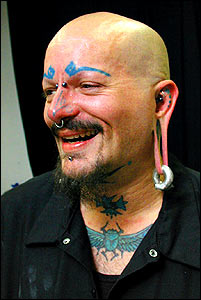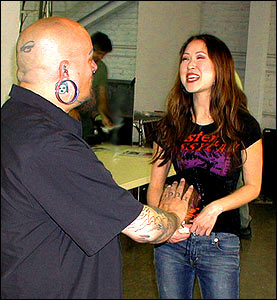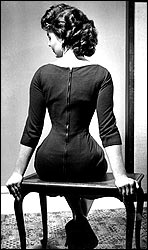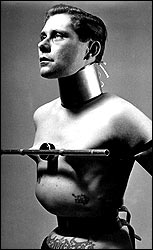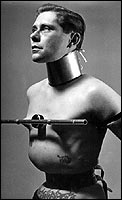 |
Beauty: Eye of the Beholder? "The body belongs to the spirit that lives inside. And to no one else." |
||||||||
|
Greetings Welcome to my new column. It's a genuine pleasure to be a contributor to BME online news for "we the alternative people". After fifty years of research, my own personal explorations and the mentoring of hundreds of others, I feel obligated to share with all those special persons "who hear the sound of a different drummer." So every month now, look for this column where I will bring you a mix of news, views and hopefully information that will empower and help you further your own passions. I welcome challenges and questions to answer in the column. So feel free to write me about whatever moves you. As an "old dad" in the body modification movement, I hope to offer this column as a clearing house for new ideas/adventures and hopefully a place to moderate some of the conflicting views that often plague us. The subject of this first column is inspired by my recent experience with a new television show now in production. The show is a series being called Eye of the Beholder in which the host, Serena Yang, is traveling all over the world to film and interview people who are different — from the moko mark revival devotees of New Zealand to gothic corset wearers in San Francisco to body piercing and tattoo fans in the U.S., Canada and Europe. The series, which will air on Discovery Channel in 2004, has an interesting and intelligent slant. Its theme is exploration of the question: What is Beauty? Serena interviewed me in depth in May 2003. She will continue interviewing folks of our ilk at the coming APP conference in Las Vegas. She is a sharp and perceptive interviewer who honed her skills interviewing such celebrities as B.B King, Carlos Santana, Ravi Shankar, Martin Scorsese, Robert DeNiro, Robert Redford, Harrison Ford and Sean Penn among others. She has a passion to ask why one does what they do. She has said of herself, "the value of listening to these people is a continuing education for me ... the reward is coming away from each person with a wider vision of the times we live in, the issues we need to explore and the choices we can make." So with that introduction, I spoke at length to Serena about Modern Primitives, body modification, body rituals, spirituality and similar topics during my May piercing school. She asked good questions and many of them started my mental processes whirling. I began to ask myself questions like: "what really differentiates the visual impact of one body alteration from another", or "is there a universal, cross-cultural way to gauge the significance of a beauty ideal"? After the interview, Serena came very close to surrendering to our persistent Intensive instructors about having her nipples pierced. We'll get her next time!
"Good to see you again last week and experience your corsets first hand! I am a corset convert now, thanks to you! I've always liked them from a fashion standpoint, but now I can appreciate them on all their myriad levels."The Price of Beauty Getting down to brass tacks (which are sometimes lovely to sit on), many of us are obsessed with being different, looking different, expressing our differences. Yes? Why are we doing this? What is the payoff? These are the kinds of questions Serena asked me in our interviews. They made me think. What is the Essence of Beauty anyway? What's the payoff? What are we, or anyone in any other culture, after by making a body alteration? First it seems obvious we wish to satisfy our own vision of ourselves, how we look and feel to ourselves. And second, and probably more important, we wish to look "beautiful" to others. Of course we must realize some "others" may have different ideas of what is beautiful and claim ownership of what is not rightfully theirs. For example, take the proposed legislative ban on tongue splitting in Illinois. And we know that most of the "others" in our culture are programmed and conditioned to certain fixed notions that may conflict with our own. And that they often try to take our bodies from us — act like they have the right to claim possession of what is ours for "God" and his emissaries, or parents and spouses, or governmental and correctional agencies, or educational and medical institutions. But we know better. The body belongs to the spirit that lives inside. And to no one else. So in context of any immediate or intimate group that accepts the truth that the body belongs to the one living inside it, the payoff often seems to be to "Stand Out in the Crowd", to be unique, to be special, to be noticed in that group. This part of the "beauty ideal" seems to be universal in all cultures. In many tribal cultures I have studied, certain members of the tribe either volunteered or were selected by elders to be modified. Example: the young males of New Guinea known as Ibitoe whose septums were pierced for large spikes and whose waists were systematically reduced to wasp-like proportions with tight belts. They were special in their communities, honored, revered. Same goes for women in Africa whose lips were pierced and enlarged to hold huge plates. The larger the plate, the more beautiful. And the Padung women of Burma/Thailand with their giraffe necks stretched to ten inches or more. So now in the mixed contemporary culture in which we live, there are conflicting standards about beauty and the way it is achieved. On the one hand there is a passion to conform to certain popular beauty ideals by "quick fixes": injections of botox or collagen, plastic surgery like liposuction or breast implants that make a rapid physical alteration. Or the taking of pills to do this or that with the body without external effort. On the other hand, a different kind of logic rules in those who modify their body in more difficult, more time consuming and more deliberate ways via tattooing, body building, piercing enlargement, corseting and similar practices. I guess that's most of us. Yes? So on a universal scale, what are some of the standards by which mankind has cross-culturally gauged the relative value of beauty? How do we rate beauty's significance on a scale of 1 to 10? After collecting information on hundreds of examples of body mods in different cultures, including our own subculture, this is what I discovered:
So far in this column, I have been examining only one aspect of what's involved with alterations of the body (what I call "Body Play"): a specific aspect labeled BEAUTY. But "beauty" only deals with the aesthetic side of life, the part of us that dwells in the five-sense world, only relevant with other people. How about the deeper side of us that operates in the "invisible world"? How about the inner emotions, feelings, spirit and energy that animates the body? Or going one step further, how about unseen forces and beings that may dwell outside the body and influence or be influenced by what is happening within body? What if body rituals dealing with the unseen world somehow play a bigger role in our life journey than those so obvious to the five senses? Body rituals like cutting, ball dances, suspensions or hook pulling? Or what if our energy added to such a "gift" delivered under hardship to an unseen deity or archetype adds value to the gift in such a way that we receive a very special blessing in return? That's what they practice in Hindu Culture in body rites and festivals like Thaipusam. The aspects of body alteration dealing with unseen forces and energies will be the subject of my next column. It will be called Body Play: State of Grace or Sickness. Again I will focus on the cultural conflicts we are all facing when we give in to our passions.
Yours for more beauty in the world and less struggle,
Copyright © 2003 BMEZINE.COM. Requests to republish must be confirmed in writing. For bibliographical purposes this article was first published May 18th, 2003 by BMEZINE.COM in Tweed, Ontario, Canada. | |||||||||
